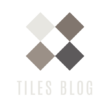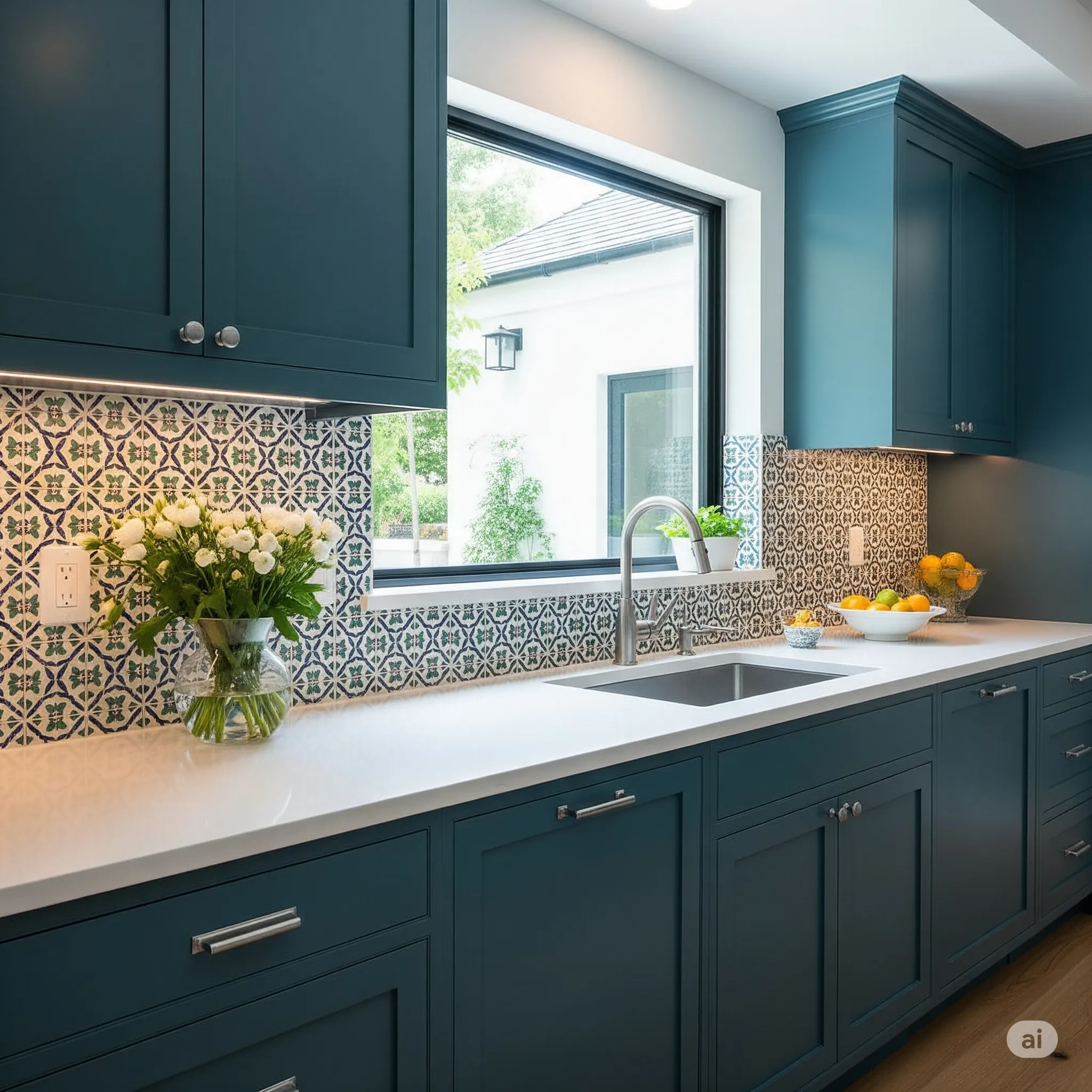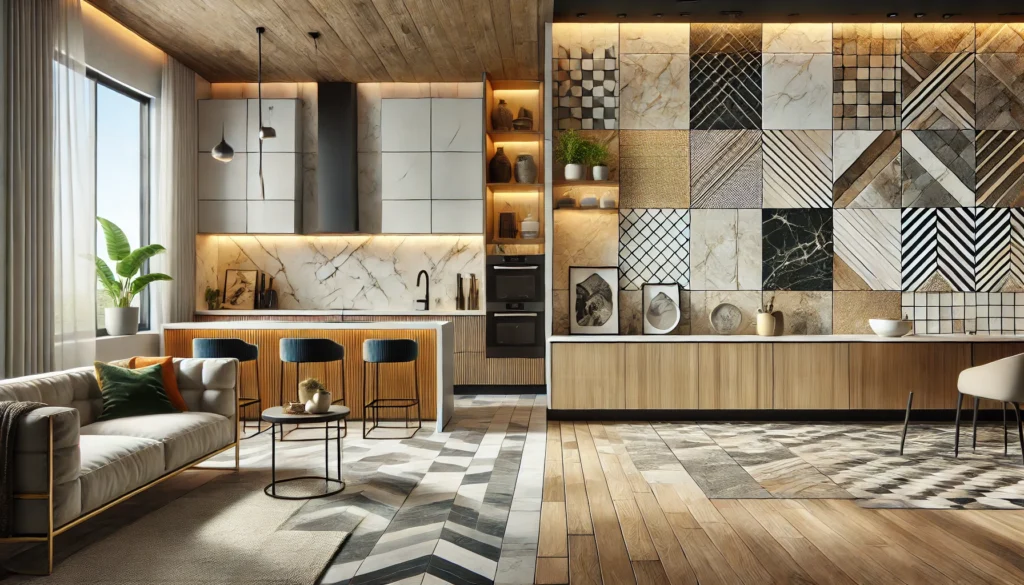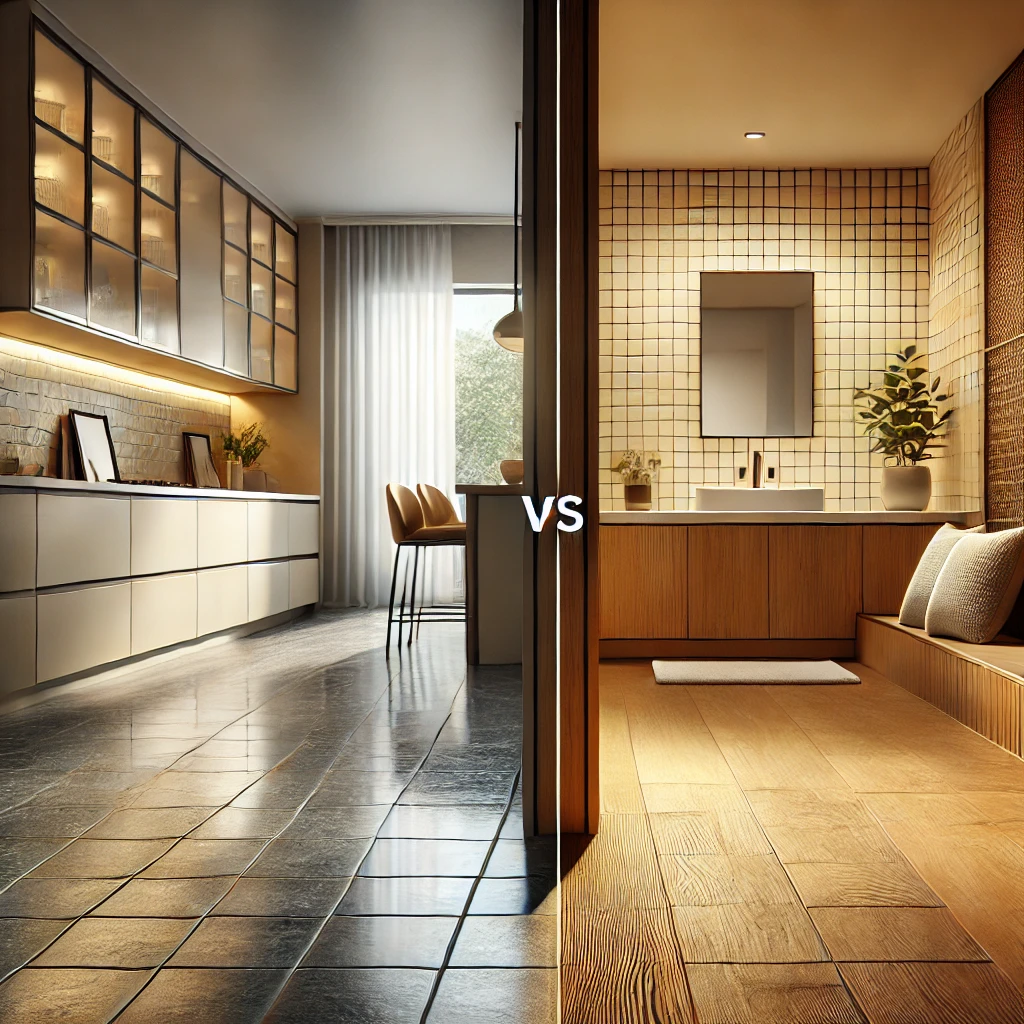Introduction: Why Are Moroccan Tiles Captivating Hearts Worldwide?
Picture this: You walk into a home, and your eyes are instantly drawn to a stunning wall that seems to tell stories of ancient palaces and exotic travels. That’s the magic of Moroccan tiles. These aren’t just decorative elements—they’re pieces of art that have been captivating designers, homeowners, and architects for over a millennium.
Moroccan ceramic tiles featuring traditional star and octagon geometric patterns in black, brown, olive, and blue tones
But what makes Moroccan tiles so irresistible in 2025? Is it their intricate geometric patterns that dance with mathematical precision? Their vibrant colors that can transform any space from mundane to magnificent? Or perhaps it’s their rich cultural heritage that adds depth and meaning to modern interiors?
The truth is, it’s all of the above—and so much more. Whether you’re renovating your kitchen, designing a spa-like bathroom, or simply wanting to add character to your living space, Moroccan tiles offer a perfect blend of tradition and contemporary appeal that no other tile style can match.
The Problem: Why Generic Tiles Fall Short in Modern Design
Let’s be honest—most tiles today are forgettable. You’ve seen them everywhere: plain subway tiles, basic ceramics, and uninspiring patterns that blend into the background. While functional, they lack soul, personality, and that wow factor that makes guests stop and stare.
Modern homeowners face several design dilemmas:
- Cookie-cutter interiors that lack personality
- Difficulty creating focal points that aren’t overwhelming
- The challenge of balancing trendy with timeless
- Limited options for adding cultural depth to spaces
- Bland backsplashes and walls that fail to inspire
Here’s where Moroccan tiles step in as the perfect solution. They solve the “boring tile problem” while addressing the growing desire for authentic, artisanal elements in our increasingly digital world.
What Are Moroccan Tiles? Understanding the Art Form
Moroccan tiles are far more than decorative surfaces—they’re a testament to centuries of artistic evolution and cultural storytelling. Originating around 700 AD in Spain and North Africa, these tiles represent the intersection of Islamic art, Berber traditions, and Moorish craftsmanship.
At their core, Moroccan tiles are characterized by:
- Geometric patterns that avoid figurative imagery, following Islamic artistic principles
- Handcrafted imperfections that give each tile unique character
- Vibrant color palettes ranging from deep cobalt blues to earthy terracottas
- Mathematical precision in their repeating patterns and tessellations
The most famous type is Zellige (or Zellij), which literally means “polished stone” in Arabic. These tiles are made from natural clay sourced from the Atlas Mountains, hand-shaped, glazed, and fired in traditional kilns—a process that has remained virtually unchanged for over 1,000 years.
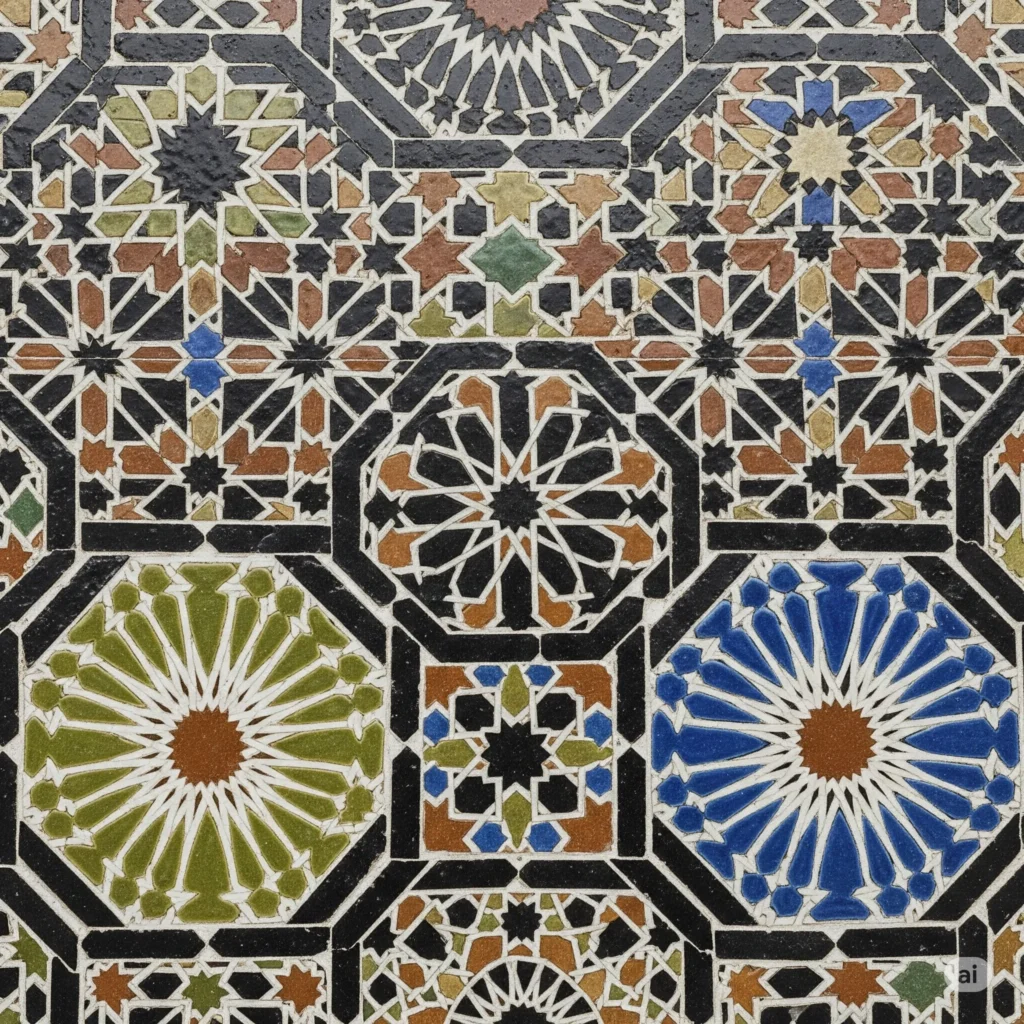
Types of Moroccan Tiles: A Complete Guide
Zellige Tiles: The Crown Jewel
Zellige tiles are the most authentic and sought-after Moroccan tiles. Made from terracotta clay and featuring a distinctive glazed finish, each tile is unique due to the handcrafting process.
Key characteristics:
- Hand-chiseled using the intricate Ciselé technique
- Available in over 50 colors
- Natural variations in texture and tone
- Highly durable when properly maintained
Bejmat Tiles: Rustic Elegance
These rectangular tiles are often used for flooring and offer a more understated approach to Moroccan tile design. Their earthy tones bring warmth to any space.
Mosaic Pattern Tiles
Combining multiple shapes and colors, these Moroccan tiles create intricate mosaics that can serve as stunning focal points in any room.
Modern Moroccan-Style Tiles
Contemporary versions made from ceramic or porcelain that replicate traditional patterns while offering enhanced durability and easier maintenance.
Popular Moroccan Tile Patterns and Their Meanings
Geometric Patterns: Mathematical Beauty
The hallmark of Moroccan tiles lies in their geometric precision. Common patterns include:
- Eight-pointed stars: Symbolizing balance, harmony, and the interconnectedness of life
- Interlocking polygons: Representing unity and the infinite nature of the universe
- Arabesques: Flowing, symmetrical designs inspired by natural forms
Color Symbolism in Moroccan Tiles
Colors in Moroccan tiles aren’t chosen randomly—each carries deep cultural significance:
- Cobalt Blue: Protection, spirituality, and tranquility
- Emerald Green: The color of Islam, representing paradise and fertility
- Terracotta Red: Power, strength, and vitality
- White: Purity and peace
- Yellow: Warmth, happiness, and energy
2025 Trends: How Moroccan Tiles Are Evolving
Monochrome Palettes
While traditional Moroccan tiles are known for vibrant colors, 2025 welcomes a shift toward black-and-white palettes that provide clean yet exotic statements.
Oversized Zellige Tiles
Larger formats reduce grout lines and make rooms appear more open and seamless while maintaining the handmade aesthetic.
Earthy, Muted Tones
Tiles in terracotta, sand, olive, and clay tones are gaining traction, perfect for boho and eco-conscious interiors.
Sustainable Materials
Modern Moroccan tiles now incorporate eco-friendly production methods and recycled materials, appealing to environmentally conscious consumers.
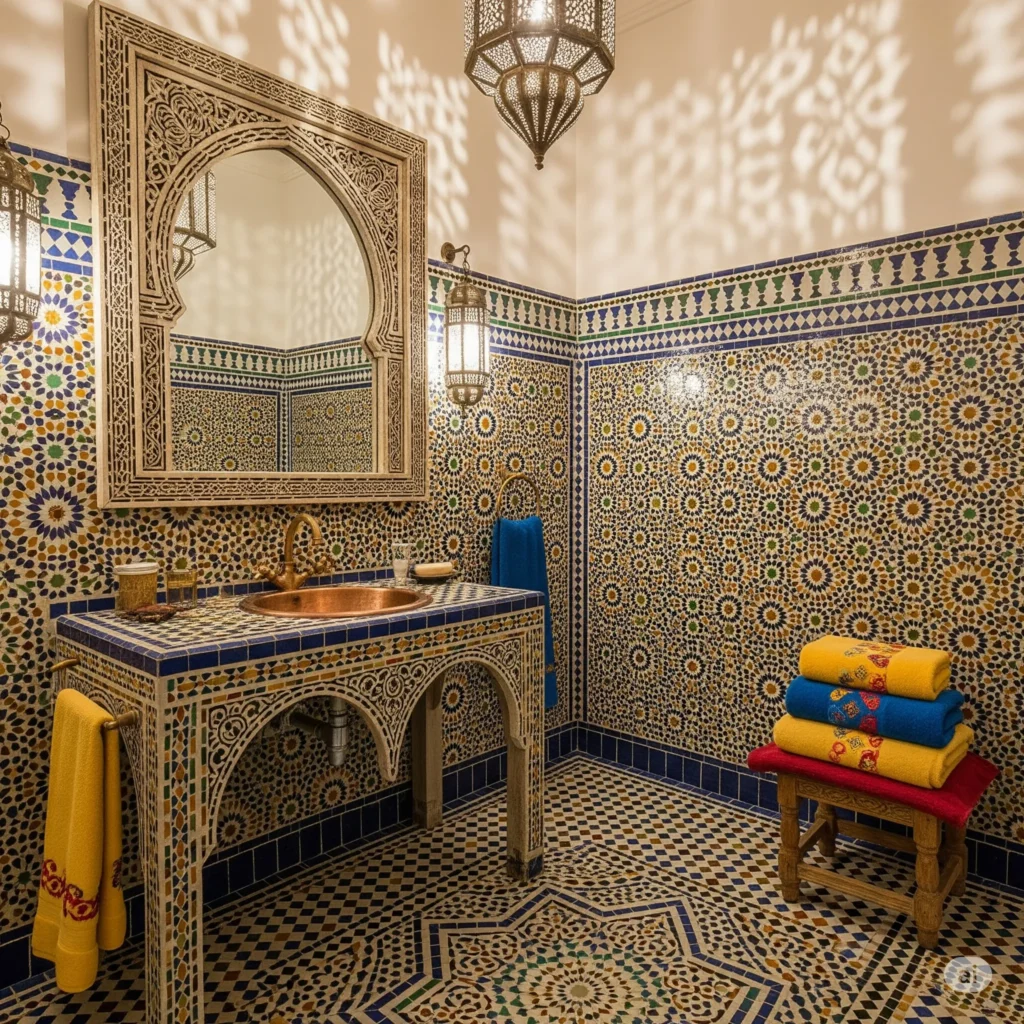
Where to Use Moroccan Tiles: Design Applications
Kitchen Backsplashes: The Star Application
Moroccan tiles transform ordinary kitchen backsplashes into works of art. Their heat resistance and easy-to-clean surface make them both beautiful and practical.
Pro tip: Use neutral-toned Moroccan tiles with busy patterns sparingly, or go bold with solid colors in intricate shapes.
Bathroom Walls and Shower Enclosures
The water-resistant properties of glazed Moroccan tiles make them perfect for bathrooms. They create spa-like atmospheres that transport you to exotic destinations.
Accent Walls
A single accent wall featuring Moroccan tiles can completely transform a living room, bedroom, or entryway without overwhelming the space.
Flooring Options
Slip-resistant Moroccan tiles work beautifully for floors, especially in entryways, patios, and outdoor spaces.
Commercial Spaces
Boutiques, restaurants, and hotels increasingly use Moroccan tiles to create memorable, Instagram-worthy interiors that stand out from competitors.
Installation Guide: DIY vs. Professional
DIY Installation: What You Need to Know
Installing Moroccan tiles can be a rewarding DIY project, but it requires patience and precision.
Essential tools:
- Tile spacers (typically 1-2mm for Moroccan tiles)
- High-quality tile adhesive
- Grout suitable for handmade tiles
- Tile nippers for cutting irregular shapes
- Level and measuring tools
Step-by-step process:
- Prepare the surface (must be clean, level, and primed)
- Plan your layout (start from the center and work outward)
- Apply adhesive in small sections
- Place tiles with slight pressure, allowing for natural variations
- Use appropriate spacers (Moroccan tiles may need irregular spacing)
- Grout carefully, cleaning excess immediately
- Seal if required (check manufacturer recommendations)
When to Hire Professionals
Consider professional installation for:
- Large areas (over 50 square feet)
- Complex patterns requiring precise cutting
- Wet areas requiring waterproofing
- Historic or high-value tile installations
Cost considerations: Professional installation typically costs ₹80-150 per square foot in India, while DIY can save 60-70% on labor costs.
Cost Analysis: Moroccan Tiles in 2025
Price Ranges by Type
| Tile Type | Price per sq. ft. (₹) | Price per sq. ft. (USD) | Best For |
|---|---|---|---|
| Basic Moroccan-style ceramic | ₹120-₹200 | $1.50-$2.50 | Budget-conscious projects |
| Mid-range porcelain Moroccan | ₹250-₹400 | $3.00-$5.00 | Kitchen backsplashes |
| Authentic Zellige (imported) | ₹500-₹800 | $6.00-$10.00 | Luxury applications |
| Custom artisanal tiles | ₹800-₹1,500 | $10.00-$18.00 | Statement installations |
Budget Planning Tips
- Calculate 10-15% extra for cuts and potential breakage
- Installation costs typically equal 30-50% of tile costs
- Grout and sealers add approximately ₹20-₹30 per square foot
- Consider mixing expensive authentic tiles with budget-friendly alternatives for maximum impact
Maintenance and Care: Keeping Your Moroccan Tiles Beautiful
Daily Maintenance
Moroccan tiles are surprisingly easy to maintain with proper care:
- Sweep or vacuum regularly to prevent grit accumulation
- Wipe with damp cloth using mild, pH-neutral cleaner
- Avoid harsh chemicals that can damage glazes
- Clean spills immediately to prevent staining
Long-term Care
- Reseal grout annually in wet areas
- Professional cleaning every 2-3 years for high-traffic areas
- Touch up chips immediately to prevent water damage
- Use coasters and mats in areas prone to scratching
Common Mistakes to Avoid
- Using acidic cleaners (vinegar, lemon) on glazed surfaces
- Excessive pressure washing that can damage grout
- Ignoring manufacturer-specific care instructions
- Over-sealing tiles that don’t require it
Design Inspiration: Real-World Applications
Case Study 1: Mumbai Apartment Kitchen
Challenge: Transform a small, dark kitchen into a bright, engaging space.
Solution: White and blue Moroccan tiles in a traditional star pattern created a stunning backsplash that reflected light and added personality without overwhelming the 80-square-foot space.
Result: The kitchen became the apartment’s focal point, increasing the property value by an estimated 12%.
Case Study 2: Bangalore Restaurant
Challenge: Create an authentic, memorable dining atmosphere in a modern commercial space.
Solution: Authentic Zellige Moroccan tiles in earthy tones covered an accent wall, complemented by warm lighting and traditional furnishings.
Result: Instagram mentions increased by 300%, and the restaurant became a popular photography destination.
Case Study 3: Chennai Bathroom Renovation
Challenge: Convert a basic bathroom into a spa-like retreat.
Solution: Multicolored Moroccan tiles in geometric patterns covered shower walls, paired with neutral floor tiles for balance.
Result: The bathroom transformation increased home resale appeal and created a daily luxury experience for the homeowners.
Advanced Design Tips for Moroccan Tiles
Pattern Mixing Strategies
- Start with one dominant pattern and add complementary designs
- Use neutral colors as bridges between busy patterns
- Follow the 60-30-10 rule: 60% neutral, 30% pattern, 10% accent
- Consider scale: Mix large and small patterns thoughtfully
Color Coordination
- Monochromatic schemes work beautifully with Moroccan tiles
- Analogous colors (neighboring on color wheel) create harmony
- Complementary accents add drama without chaos
- Metallics (gold, brass, copper) enhance the luxury feel
Lighting Considerations
Moroccan tiles respond dramatically to different lighting:
- Natural daylight shows true colors and textures
- Warm LED strips enhance glazed surfaces’ reflective qualities
- Accent lighting can highlight pattern details
- Avoid harsh fluorescent lighting that flattens designs
Comparing Moroccan Tiles with Other Options
| Feature | Moroccan Tiles | Subway Tiles | Natural Stone | Porcelain |
|---|---|---|---|---|
| Visual Impact | High | Medium | Medium | Variable |
| Cultural Depth | Exceptional | Minimal | Moderate | Minimal |
| Maintenance | Moderate | Low | High | Low |
| Cost | ₹120-₹1,500/sq.ft | ₹80-₹200/sq.ft | ₹200-₹800/sq.ft | ₹100-₹400/sq.ft |
| Durability | High (when quality) | High | Very High | Very High |
| Design Flexibility | Exceptional | Limited | Moderate | High |
Common Mistakes to Avoid
Design Mistakes
- Overusing patterns: More isn’t always better with Moroccan tiles
- Ignoring room scale: Large patterns can overwhelm small spaces
- Clashing with architecture: Ensure tiles complement your home’s style
- Poor lighting planning: Moroccan tiles need proper illumination to shine
Technical Mistakes
- Skipping surface preparation: Uneven surfaces show more with handmade tiles
- Wrong adhesive choice: Use flexible adhesives for natural variations
- Inadequate waterproofing: Especially critical in wet areas
- Rushing the process: Handmade tiles require patience and precision
Sustainability and Moroccan Tiles
Traditional Eco-Friendly Aspects
Moroccan tiles have always been relatively sustainable:
- Natural clay materials from local sources
- Traditional firing methods using local fuel sources
- Longevity reduces replacement needs
- Repairable individual tiles can be replaced without full renovation
Modern Improvements
Contemporary Moroccan tile manufacturers are embracing:
- Solar-powered kilns for reduced carbon footprint
- Recycled content in non-traditional versions
- Local production to reduce transportation impact
- Water conservation in manufacturing processes
Future of Moroccan Tiles: What’s Next?
Technology Integration
- Digital pattern creation while maintaining handmade aesthetics
- 3D printing for complex custom shapes
- Smart tiles with integrated lighting or heating elements
- Augmented reality for design visualization
Market Trends
According to industry reports, the global decorative tile market is expected to grow by 8.2% annually through 2028, with Moroccan tiles representing one of the fastest-growing segments.
Key drivers:
- Increased interest in artisanal, handmade products
- Social media influence on interior design choices
- Growing appreciation for cultural authenticity
- Rising disposable income in emerging markets
Professional Tips from Interior Designers
Dos:
- Start small: Test patterns with sample tiles before committing
- Consider the whole room: Moroccan tiles should complement, not compete
- Invest in quality: Authentic tiles last decades with proper care
- Plan for variations: Embrace the handmade imperfections
Don’ts:
- Don’t rush decisions: Live with samples for a few days
- Avoid trend-chasing: Choose patterns you’ll love long-term
- Don’t ignore practicality: Consider maintenance in your choice
- Avoid mixing too many patterns: Less is often more
Conclusion: Transform Your Space with Timeless Moroccan Elegance
Moroccan tiles offer something truly special in our world of mass-produced mediocrity—authenticity, artistry, and a connection to centuries of cultural heritage. Whether you choose traditional handcrafted Zellige or modern interpretations, these tiles transform ordinary spaces into extraordinary experiences.
The investment in Moroccan tiles pays dividends beyond aesthetics. You’re not just buying a surface covering; you’re investing in:
- Timeless beauty that won’t go out of style
- Increased property value through distinctive design
- Cultural richness that tells a story
- Artisanal quality that supports traditional crafts
- Personal satisfaction from creating unique, beautiful spaces
Ready to bring the magic of Morocco into your home? Start by exploring different patterns and colors, consider your space’s specific needs, and don’t be afraid to dream big. Your perfect Moroccan tile installation is waiting to transform your space from ordinary to extraordinary.
Take action today: Visit local tile showrooms, request samples, and begin planning your own Moroccan-inspired transformation. Your future self will thank you every time you see those gorgeous patterns catching the light just perfectly.
FAQs About Moroccan Tiles
1. Are Moroccan tiles suitable for high-moisture areas like shower walls?
Yes! Properly glazed Moroccan tiles are excellent for bathrooms and showers. Just ensure proper waterproofing behind the tiles and use appropriate grout suited for wet areas.
2. How do I clean Moroccan tiles without damaging the finish?
Use mild, pH-neutral cleaners with a soft cloth or sponge. Avoid acidic cleaners (vinegar, lemon) and abrasive materials that can scratch the glaze. For stubborn stains, use a paste of baking soda and water.
3. Can I install Moroccan tiles myself, or do I need a professional?
DIY installation is possible for small areas if you have tiling experience. However, Moroccan tiles require patience due to natural variations. For large areas or complex patterns, professional installation ensures the best results.
4. What’s the difference between authentic Zellige and Moroccan-style tiles?
Authentic Zellige is handmade in Morocco using traditional clay and methods, resulting in unique variations and higher costs. Moroccan-style tiles are machine-made reproductions that offer similar aesthetics at lower prices with more consistency.
5. How much should I budget for a Moroccan tile project?
Budget ₹200-₹1,200 per square foot including tiles and installation. Authentic Zellige costs more but offers unmatched character. Factor in 10-15% extra for cuts and potential repairs. Always get quotes from multiple suppliers and installers.
